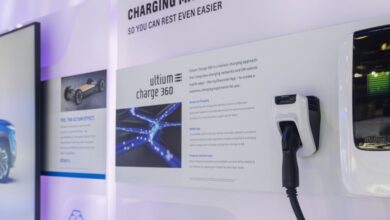‘Yes, Lego car!’: why small electric cars could be about to break the grip of SUVs | Automotive industry

Driving through central London in a tiny Microlino electric car, barely visible between the hulking SUVs, it’s surprising to be the focus of so much attention. “Yes, Lego car!” shouts a scaffolder.
Made by Micro, the family-owned Swiss company behind the mini-micro kick scooters, and modelled on the bubble cars that had a brief heyday in the 1950s, the two-seater is only 2.5 metres long – marginally smaller than a Smart car. The most unusual feature is its one and only door (there is also a rear hatch for accessing the boot), which is at the front. The windscreen and bonnet swing open to let you in.
The Microlino goes on sale in the UK this month, in the face of a trend that is pushing the car industry in the opposite direction. Despite global heating, and the warnings of environmental scientists, the demand for ever larger cars just keeps growing.
Nearly half of global car sales were sports utility vehicles (SUVs) in 2023, according to the International Energy Agency (IEA), a respected forecaster. The definition of SUVs can be vague (usually something to do with a higher seating position and off-road styling), but the IEA this week said “the shift towards every larger and heavier cars” is the “defining automobile trend of the early 21st century”.
Tiny cars are still a rarity, and the Microlino is enough to cause a stir. Uncountable people double take, wave, laugh and take pictures. Cyclists lean over to chat at traffic lights; a bus driver delays his passengers a few seconds to give a double thumbs up; a taxi driver suggests it could help this reporter’s romantic life.
It feels at home nipping around town, although with 136 miles of range and a 56mph top speed it could manage jaunts farther afield.
Squeezing into a tiny space between a Bentley and a Land Rover Defender, the Microlino parks face-out under the watchful gaze of a bystander who turns out to be the owner of both luxury cars. This is in the posh London district that gave its name to the “Chelsea tractor”, where the four-wheel drive has become standard issue even if the residents rarely need off-road vehicles to make it to the shops and back.
The reach of the SUV now goes far beyond Chelsea, however. David Bailey, a professor of business economics at the University of Birmingham, said different pressures have contributed towards bigger cars. Customer demand for the space and a commanding seating position is part of it. Regulation is another: airbags and emissions control systems (such as AdBlue for diesels) add a larger percentage to costs in smaller cars.
“If a firm produces a small car that takes up a space on the production line, and that is an opportunity cost where they could make a more profitable bigger car,” Bailey said. However, he added, “if you make it at volume you can still make a decent profit margin”.
Even the Mini has outgrown its name. Perhaps Britain’s best-known car, it was conceived at a time when postwar fuel rationing made efficiency attractive. The original was 3.05 metres long. Then, at a 2011 relaunch, it grew to 3.7 metres. One of the latest versions, the steroidal electric Mini Countryman (“the biggest Mini ever”) has more in common with a Land Rover, at 4.4 metres.
Some other brands have gone the same way. Smart’s Fortwo was the most familiar tiny car on European roads, but the new electric models (under part-Chinese ownership) are significantly bigger five-seaters.
The results of car growth are not good for the environment. Two hundred kilograms or more in extra weight for SUVs plus the extra drag from a bigger frontal surface area mean burning more fossil fuels. That pushes up carbon emissions by 20%, the IEA said. A quarter of global growth in oil demand last year can be ascribed to petrol SUVs. Electric SUVs use up far more valuable minerals such as lithium, nickel and cobalt than smaller vehicles, making decarbonisation goals harder.
Bigger vehicles also add to tyre pollution, and they make pedestrian deaths much more likely, for women and children in particular.
And they take up more space. SUVs need 0.3 sq metres extra, which adds to parking requirements and gums up city streets. By contrast, the tiny Microlino can slip into the smallest of gaps.
Colin Walker, head of transport at the Energy and Climate Intelligence Unit thinktank, is hopeful that the imminent launch of smaller, cheaper electric models such as the Renault 5 and the £14,995 Dacia Spring will help speed the transition from fossil fuels.
“One of the main barriers that is holding people back is the lack of smaller, cheaper EVs,” he said. “I’d argue that [manufacturers] were a little show in trying to build these models.”
Of the big western manufacturers, only Stellantis – the owner of Citroën, Peugeot, Chrysler, Vauxhall and others – has ventured into the truly tiny electric car segment. Its £8,095 Citroën Ami has gained something of a cult following despite its 28mph top speed and 46-mile range. It is particularly popular with high school students in France, where the self-proclaimed “urban mobility object” is classed as a light quadricycle, meaning it can be driven by anyone aged 14 or over without a full licence.
Yet it is China that is extending its growing electric car dominance into the realm of tiny cars, often based on cheap lithium iron phosphate (LFP) batteries. Those on sale in China (but not yet in Europe) include Geely’s £6,000 Geometry Panda, the £3,400 Mini EV from Wuling Hongguang and the £9,100 Baojun Yep, a joint production between SAIC and the US’s General Motors, which offers SUV styling in a tiny package.
For slightly larger hatchbacks, the competition is fierce. SAIC’s MG4 has already conquered the UK market, where the brand originated. BYD’s impressive Dolphin is expected to make a big splash in the market for small family cars.
Merlin Ouboter, who oversaw the Microlino project and whose father, Wim, made Micro into a household name with its scooters, is hoping that he can steal a march on European rivals in the tiny car segment (although a premium £22,000 price tag and some flimsy parts suggest it has a fair way to go to be a mass seller).
“Most of the cars we see on the road today are completely overengineered for their daily use case,” Ouboter said. The Microlino is aimed at the vast majority of journeys (94% in the UK) that are less than 25 miles. For the rest, he envisages greater use of occasionally shared or rented cars.
James Nix of the Brussels-based campaign group Transport & Environment says other governments should emulate France, which imposes higher parking fees in Paris for big cars, and higher sales taxes nationally. That could help halt the annual swelling in the size of new cars towards the scale of metal monsters in the US.
“Do we as Europeans want to replicate the evolution of the North American car fleet?” Nix asked. “I don’t think that question has been asked at a political level yet.”



